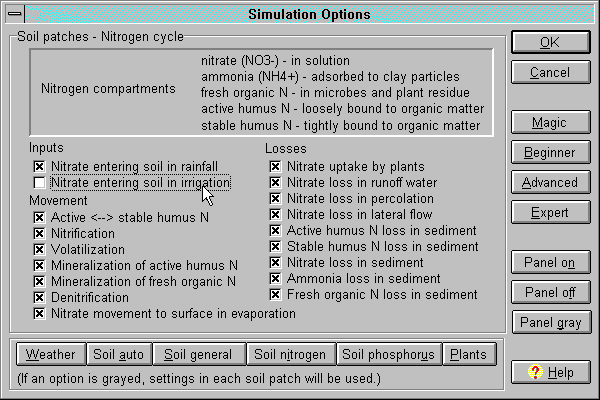Garden with Insight v1.0 Help: Simulation options window: soil nitrogen panel
In the simulation options window, the soil nitrogen panel contains the
following items. Click on the Soil nitrogen button at the bottom of the window to see the soil
nitrogen panel.
The check boxes in the Soil nitrogen panel control whether various processes are carried out by the model every day of the simulation. If an option is
checked, the process is turned ON for all soil patches, overriding any individual settings.
This is the default when you create a new garden. If an option is unchecked, the process
is turned OFF for all soil patches. If an option is grayed (filled in but
not checked), settings in individual soil patches are used for the option. You can change options for
individual soil patches in the browser (see the Soil params options group). By default each soil patch has
all processes turned on when it is created.
Inputs
Nitrate entering soil in rainfall: Allow nitrate to enter the soil in
rainfall. The concentration of nitrate in rainfall is a soil parameter. [how
nitrate from rainfall works]
Nitrate entering soil in irrigation: Allow nitrate to enter the soil in irrigation water. The
concentration of nitrate in irrigation water is constant. [how nitrate from
irrigation works]
Movement
Active <> stable humus N: Allow flow from active to stable nitrogen in the humus (organic
matter). An equilibrium equation based on a rate constant and on the number of years the soil had been
cultivated when the soil patch was created (a parameter). [how active-stable
humus N flow works]
Nitrification: Allow nitrification, the conversion of ammonia to nitrate (by aerobic soil bacteria).
This depends on soil temperature, water content, and pH being at the best levels for aerobic bacteria to
survive. [how nitrification works]
Volatilization: Allow volatilization, the loss of ammonia to the atmosphere. For the top soil
layer, is increased by higher wind speed and temperature. For other soil layers, is increased by low cation-
exchange capacity, high temperature, and proximity to the surface. [how
volatilization works]
Mineralization of active humus N: Allow mineralization of active humus N to nitrate by soil
microbes. Reduced by factors that inhibit microbial activity: soil dryness, low soil temperature, and/or soil
compaction (increase in bulk density). Humus P mineralization depends on this. [how mineralization of active humus N works]
Mineralization of fresh organic N: Allow mineralization of fresh organic nitrogen (by microbes).
Depends on soil water, temperature, and C:N and C:P ratios in flat residue. 80% of mineralized fresh
organic N goes into nitrate, and 20% returns to active humus N as dead microbial biomass. [how mineralization of fresh organic N works]
Denitrification: Allow denitrification, the loss of soil nitrate to the atmosphere due to the
creation of volatile products by anaerobic bacteria when the soil is waterlogged. Depends on soil water
content and to a lesser extent on soil temperature and organic matter. [how
denitrification works]
Nitrate movement to surface in evaporation: Allow water moving up through the soil because of
evaporation from the soil surface to carry nitrate with it. [how nitrate
movement from evaporation works]
Losses
Nitrate uptake by plants: Allow plants to absorb nitrate from the soil. [how plant N allocation and uptake works]
Nitrate loss in runoff water: Allow nitrogen leaching (as nitrate) in water that runs off the soil
surface. [how nitrate loss in runoff water works]
Nitrate loss in percolation: Allow nitrogen leaching (as nitrate) in water that percolates
downward through the soil. [how nitrate loss in percolation works]
Nitrate loss in lateral flow: Allow nitrogen leaching (as nitrate) in water lost by lateral
subsurface water flow. [how nitrate loss in lateral flow works]
Active humus N loss in sediment: Remove a quantity of active humus nitrogen from the first soil
layer proportional to the amount of soil lost from that layer during erosion. [how nutrient loss in sediment works]
Stable humus N loss in sediment: Remove a quantity of stable humus nitrogen from the first soil
layer proportional to the amount of soil lost from that layer during erosion.
Nitrate loss in sediment: Remove a quantity of nitrate from the first soil layer proportional to the
amount of soil lost from that layer during erosion. (This is not in EPIC and was added by us.)
Ammonia loss in sediment: Remove a quantity of ammonia from the first soil layer proportional
to the amount of soil lost from that layer during erosion. (This is not in EPIC and was added by us.)
Fresh organic N loss in sediment: Remove a quantity of fresh organic nitrogen from the first soil
layer proportional to the amount of soil lost from that layer during erosion. (This is not in EPIC and was
added by us.)

The simulation options window with soil nitrogen panel
| 
